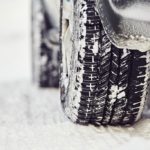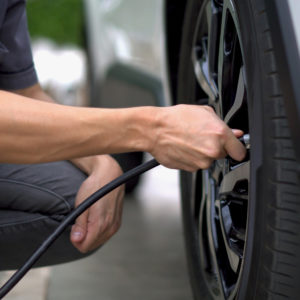Tubeless tires don’t have inner tubes, as their name implies. This seemingly simple innovation allows them to be more durable and puncture-resistant. To compensate for not having a tube, tubeless tires are designed to be impermeable, which prevents air from leaking out. At the same time, tubeless tires are only compatible with specially designed rims that allow the tire bead to form a strong airtight seal with the rim.
Are car tires tubeless? Mostly. Nowadays, most passenger vehicle tires use tubeless tires. However, inner tubes can still be found on tires in large trucks, buses, or other large vehicles, albeit in rare instances.
Key Benefits of a Tubeless Tire
Tubeless car tires have several advantages over their tubed counterparts:
Tubeless Tires Are Safer
A conventional tire with a tube will rapidly deflate like a balloon as soon as it’s punctured. This is because the air in the inner tube rapidly escapes at the puncture point, which widens the hole and accelerates the loss of air.
At high speeds, this can cause the wheel to bottom out immediately, which will cause the wheel to lose traction. Once this happens, the vehicle can become undriveable and get into a major accident.
Tubeless tires are significantly safer because they don’t deflate rapidly when the tread is punctured. This can give the driver precious time to slow down before the wheel bottoms out. The tire can mitigate damage so well that small punctures can even be imperceptible since they let out air slowly. This gives drivers plenty of time to drive to an auto repair shop to have the tire fixed.
How do tubeless tires prevent blowouts? It’s mainly due to the rubber’s stiffness. When tubeless tires are punctured, the hole will remain the same size because the tire’s rubber is stiff enough to prevent the hole from expanding.
Tubeless Tires Can Self Seal
Tubeless tires can be installed with sealant inside, which allows the tire to self-seal when punctured. When a puncture happens, the air pressure pushes the sealant into the puncture hole. Sealant has special fibers and particles that accumulate and bond around the puncture, forming a kind of rubber plug that prevents air from escaping further.
Tubed tires also tended to deflate out of the blue because of tiny punctures on the inner tube. Tubeless tires, even without sealant, are much less likely to deflate because of a small object penetrating the tread.
Tubeless Tires Are Impermeable
Conventional tube tires are permeable, which means air molecules can permeate in between the rubber molecules. This is why tubed tires need inner tubes. Meanwhile, tubeless tires can keep air inside the tire because they have an impermeable layer sandwiched inside the rubber that prevents air from penetrating in between rubber molecules.
Tubeless Tires Have Better Performance;
Tubeless tires can also offer improved ride quality and efficiency, as removing the inner tube results in less rolling resistance. Tubeless tires are also lighter, which means there’s less rotating mass. This allows the vehicle to accelerate faster and brake more effectively.

How to Inflate Tubeless Tires
Inflating tubeless tires is straightforward. You can use a manual floor pump, however this will take significantly more time. Using an air compressor would be much more preferable. The tire will be able to hold air as long as the tire has been correctly installed onto the rim.
Every vehicle has a recommended tire pressure, which can be found inside the vehicle’s owner’s manual or on a sticker located on the driver’s side door jamb. Pump the tire until the tire isn’t sagging on the floor anymore and then periodically check the tire pressure with a gauge. Then, repeat inflating the tire or deflating the tire until the tire reaches its ideal tire pressure.
Keep in mind that front and rear tires can have different recommended tire pressures since vehicles don’t distribute their weight evenly.
Once you’ve inflated the tire to its recommended pressure, reinsert the valve cap to protect the sensitive components of the valve. Keep in mind that tires regularly lose around 1 to 3 pounds per square inch (psi) of pressure per month. Hence, you should check and inflate your vehicle’s tire pressure monthly and reinflate the tire if the pressure is low. This ensures that you’re running the correct air pressure, which will result in less tire wear and a more efficient ride.
Any information provided on this Website is for informational purposes only and is not intended to replace consultation with a professional mechanic. The accuracy and timeliness of the information may change from the time of publication.
































